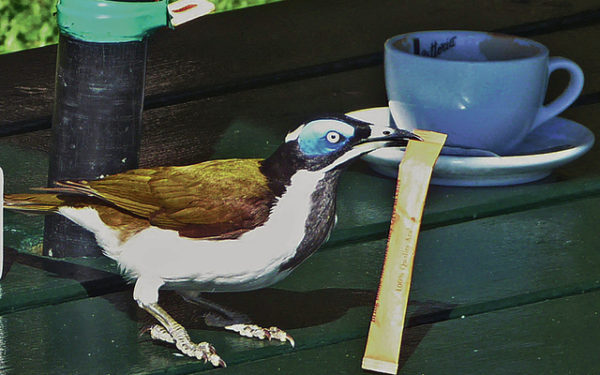Published in the Ocean Watch column, Honolulu Star-Advertiser © Susan Scott
May 21, 2016
KEPPEL BAY MARINA, Yeppoon, Australia >> Craig and I are back in Australia to collect our 37-foot ketch, Honu, and explore more of the Great Barrier Reef.
We’ve sailed here before, but with over 1,000 miles of reef, 300-some islands and Queensland’s east coast packed with national parks, we’ve barely scratched the surface.
Just hours after we arrived in this marina where we had left Honu, three thieves appeared. We were sitting outdoors in the marina’s restaurant, The Waterline, recovering from jet lag with double lattes, when down they swooped. They were so adorable they didn’t need to steal. I would have given them the entire restaurant.
 A blue-faced honeyeater is a tropical bird about the size of our mynahs
A blue-faced honeyeater is a tropical bird about the size of our mynahs
but with the striking colors typical of many Australian birds.
This honeyeater finished the latte behind it and then stole a packet of sugar.
©2016 Susan Scott
The bandits were blue-faced honeyeaters, tropical birds about the size of our mynahs but sporting the eye-popping colors typical of so many Australian birds.
The honeyeaters’ yellowish-green backs and black-and-white chests glowed in the morning sun, but it’s their striking faces that gave these birds their name. Bright blue patches encircle yellow eyes that are constantly on the alert for food. And not just any food: Blue-faced honey-eaters are crazy about sweets including flower nectar, honey and bananas. Given this sweet tooth, the birds that live around the marina’s restaurant have learned the contents of the brown paper tubes that servers place on tables when customers order coffee or tea: delicious raw sugar.
Blue-faced honeyeaters also love milk, and have been seen regurgitating milk to their nestlings. That makes the birds also interested in leftover liquids inside cups.
The clever birds sat silent and nearly invisible in the trees above the courtyard tables, waiting for the coffee drinkers to leave. Because the staff is onto the robbers, the birds must be quick.
And quick they are. Seconds after the family next to us left, three honeyeaters swooped down, ducked their heads into the cups for the milky leftovers, grabbed a sugar packet each and were gone.
The good-natured waitress saw me taking pictures and let the birds have their prizes.
“They’re polite,” she said of the honeyeaters. “Once they get a packet, off they go.” Straight to the shoreline, we learned. The birds take the sugar packets to the water’s edge, wetting the paper for easier opening. The beach there is often littered with brown paper tubes.
As I write, Craig and I are sailing north from the area, but reluctantly, agreeing that Rosslyn Bay and the Keppel Islands are so fantastic we could spend our entire month right here. That’s why they call this barrier reef great.